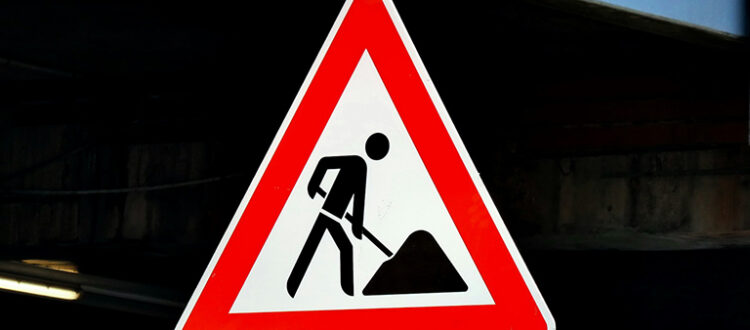Road work construction signs are essential elements of maintaining safety and organization on roads undergoing construction or maintenance. These signs serve as crucial communication tools, alerting drivers and pedestrians to potential hazards, changes in traffic patterns, and temporary speed limits.
By providing clear and visible instructions, these signs help to minimize accidents, reduce traffic congestion, and ensure the smooth flow of vehicles through construction zones. Whether it’s indicating lane closures, detours, or road conditions, they play a vital role in keeping everyone on the road, including construction workers, motorists, and pedestrians safe and informed.
What Material are Road Work Construction Signs Made of?
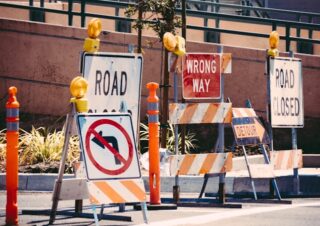 Road work construction signs are made of durable and weather-resistant materials to withstand the outdoor elements and ensure long-term visibility. Common materials used for these signs include aluminum and vinyl (PVC) coated with retro-reflective sheeting. Aluminum signs are popular due to their lightweight nature, corrosion resistance, and ability to retain their shape even in harsh conditions.
Road work construction signs are made of durable and weather-resistant materials to withstand the outdoor elements and ensure long-term visibility. Common materials used for these signs include aluminum and vinyl (PVC) coated with retro-reflective sheeting. Aluminum signs are popular due to their lightweight nature, corrosion resistance, and ability to retain their shape even in harsh conditions.
Reflective sheeting, such as high-visibility fluorescent and/or HIP (High Intensity Prismatic), enhance the visibility of signs, especially during low-light conditions or at night, contributing to overall safety on the road. These materials are chosen for their durability, visibility, and ability to withstand the rigors of outdoor use, ensuring that road work construction signs effectively convey important information to road users.
Do Road Work Construction Signs Need to be Reflective?
Yes, they need to be reflective to ensure visibility and safety, especially during low-light conditions or at night. Retro-reflective materials, such as high-visibility fluorescent colors and HIP reflective sheeting, enhance the visibility of road work construction signs, making them easier to see for drivers and pedestrians. This reflective quality is crucial for maintaining safety in construction zones, as it allows signs to remain conspicuous in various lighting conditions, reducing the risk of accidents and ensuring that road users can clearly discern important information, such as lane closures, detours, and speed limits.
They are essential for maintaining safety and visibility, particularly in challenging lighting conditions. Whether it’s in the early morning, late evening, or during adverse weather, reflective signs ensure that important information remains visible to drivers and pedestrians. By utilizing reflective materials, road work construction signs can effectively communicate warnings, directions, and information about road conditions, contributing to the overall safety and organization of construction zones. This reflective quality is crucial for ensuring that road users can navigate construction areas with heightened awareness and minimal disruption, ultimately enhancing safety for both workers and the traveling public.
What is the Recommended Shape for Road Work Construction Signs?
 The recommended shapes are diamond or rectangular shape. The FHWA’s Manual on Uniform Traffic Control Devices, or the MUTCD, has chosen these shapes as the standard, with various colors, copy, and pictograms, as the standards by which US drivers recognize that important traffic information.
The recommended shapes are diamond or rectangular shape. The FHWA’s Manual on Uniform Traffic Control Devices, or the MUTCD, has chosen these shapes as the standard, with various colors, copy, and pictograms, as the standards by which US drivers recognize that important traffic information.
The diamond shape with orange background and black lettering and pictogram, is commonly used for temporary warning signs, such as those indicating upcoming construction, road hazards, or other traffic conditions. This shape and color stand out to alert drivers to potential dangers ahead.
Rectangular signs with white backgrounds are often used for regulatory and informational purposes, providing guidance on speed limits, lane closures, detours, and other essential details. Both shapes are designed to maximize visibility and legibility, ensuring that road signs effectively communicate crucial information to motorists and pedestrians, contributing to overall safety on the road.
What is the Color of Road Work Construction Signs?
The color is typically orange, which is chosen for its high visibility and ability to alert road users to temporary changes and potential hazards. The vibrant orange color stands out against the surrounding environment, making the signs easily noticeable to drivers and pedestrians. This color is universally recognized as a symbol of caution and is commonly associated with construction and maintenance activities. By using orange as the primary color for road work construction signs, transportation authorities aim to ensure that these signs effectively convey important information and warnings to road users, contributing to overall safety and organization in construction zones.
How Big Should Road Work Construction Signs Be?
They should be large enough to be clearly visible to drivers and pedestrians from a distance. The size of these signs is typically determined by factors such as the speed limit of the road, the nature of the construction activity, and the surrounding environment. For highways and roads with higher speed limits, larger signs are necessary to ensure visibility and readability from a distance. Additionally, the size of the signs should comply with local regulations and standards to effectively convey important information to road users. By ensuring that road work construction signs are appropriately sized, transportation authorities can enhance safety and provide clear guidance to motorists navigating construction zones.
Common Road Work Construction Signs
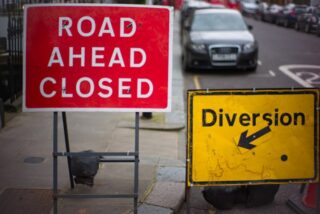 1. Detour signs (G20-2)
1. Detour signs (G20-2)
2. Work zone signs (W16-2-O)
3. Curve signs (W21-6-O)
4. Flag signs (M4-9)
5. Lane closure signs (W20-1)
6. Speed limit signs (W21-7-O)
7. Stop signs (R1-3)
8. Yield signs (W20-2)
9. No passing zone signs (W22-1-O)
10. Road closed signs (R1-4)
11. Merge signs (W20-3)
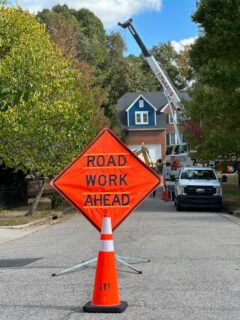 12. Divided highway signs (W22-2-O)
12. Divided highway signs (W22-2-O)
13. One way signs (W1-2L-O)
14. Two way signs (W20-3-street)
15. Keep right signs (W22-3-O)
16. Keep left signs (W1-2R-O)
17. Road work ahead signs (W20-4)
18. Flagger ahead signs (W3-1a)
19. Workers ahead signs (W1-3L-O)
20. Slow down signs (W20-5)
These signs play a crucial role in communicating important information and warnings to road users, contributing to overall safety and organization in construction zones.
Do Road Work Construction Signs Need to be MUTCD-Compliant?
Yes, they are required to be MUTCD-compliant. The Manual on Uniform Traffic Control Devices (MUTCD) sets the standard for the design, application, and placement of traffic control devices, including road work construction signs in the United States. Adhering to MUTCD guidelines ensures that road work signs are consistent, recognizable, and effectively convey essential information to road users. By being MUTCD-compliant, these signs contribute to the overall safety and efficiency of the transportation network, providing clear guidance to motorists and pedestrians navigating construction zones.
How Durable are Road Work Construction Signs?
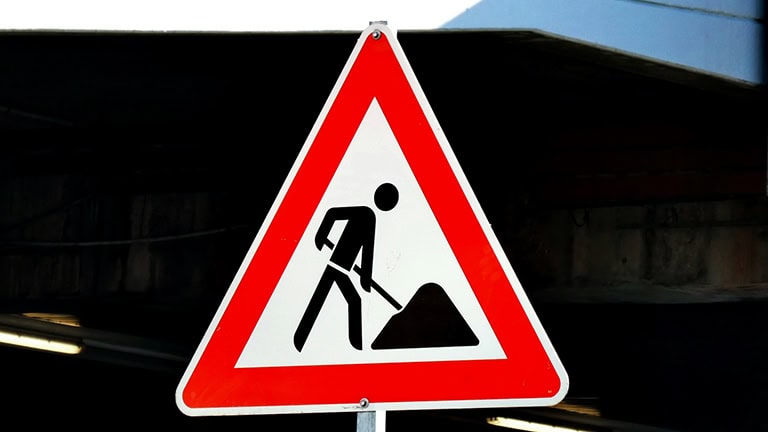 They are designed to be highly durable in order to withstand various environmental conditions and provide long-term functionality. These signs are typically constructed using materials such as aluminum, PVC (vinyl – for moveable signs),and fiberglass, which are chosen for their resilience and ability to withstand outdoor elements.
They are designed to be highly durable in order to withstand various environmental conditions and provide long-term functionality. These signs are typically constructed using materials such as aluminum, PVC (vinyl – for moveable signs),and fiberglass, which are chosen for their resilience and ability to withstand outdoor elements.
Also, the signs are reflectively sheeted with High Intensity Prismatic (HIP) sheeting to enhance visibility; this coating also adds an extra layer of protection against weathering, UV exposure, and abrasion. By utilizing durable materials and protective coatings, road work construction signs are able to maintain their integrity and visibility over extended periods, contributing to the safety and effectiveness of construction zones.
Conclusion
Road work construction signs play a crucial role in maintaining safety and organization in construction zones. From their vibrant orange color and large, visible size to their compliance with MUTCD standards and durable construction, these signs are carefully designed to effectively convey essential information to road users. By adhering to strict standards and utilizing durable materials, these signs contribute to the overall efficiency and safety of the transportation network, ensuring that construction activities can be carried out with minimal disruption and risk to all road users.
Popular Posts:

